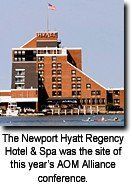One of the longest nerves in the body is known as the vagus nerve (VN). The VN is the 10th pair of cranial nerves that originates at the brain stem in the medulla oblongata. This nerve is part of the parasympathetic nervous system, which is a part of the ANS. Research suggests ear acupuncture can activate the VN.
The Ongoing Voyage: A Review of the AOM Alliance's 2005 Annual Conference
The first weekend in May drew hundreds of acupuncturists to the Hyatt Regency Hotel & Spa in Newport, Rhode Island to participate in the Acupuncture and Oriental Medicine Alliance's 12th annual conference and exposition. The conference was one of the Alliance's most successful events, featuring a combination of business, education and politics, while still allowing participants time to celebrate the achievements of the acupuncture community.
The conference featured an array of educational seminars, workshops, and special events that offered something for all attendees. More than 50 different classes and seminars were held, providing educational opportunities for practitioners anxious to meet continuing education requirements. Instructors and lecturers at the gathering featured many of the leading figures in the acupuncture world, not just from the United States, but internationally.

Robert Duggan, founder and president of the Tai Sophia Institute in Maryland, kicked off the conference with a well-received keynote address. Other speakers included many practitioners whose names are renowned throughout the acupuncture community, including Jeff Nagel, Richard Tan, Michael Gaeta, Haihe Tian, and France's own Tran Viet Dzung. The conference also featured several workshops and lectures held by some of the profession's upcoming leaders, including Eric Schneider, Brian Carter, Arya Nielsen, and Liliane Papin.
Many of the acupuncture world's leading organizations gathered to conduct official business proceedings as well. The Accreditation Commission for Acupuncture and Oriental Medicine (ACAOM), the Council of College of Acupuncture and Oriental Medicine (CCAOM), the Federation of Acupuncture and Oriental Medicine Regulatory Agencies (FAOMRA) and the Alliance Board of Directors all held a series of meetings throughout the conference, deliberating on issues such as the approval of acupuncture programs, entry-level standards for acupuncture students, and changes in educational criteria. The Alliance also held its annual membership meeting during the event, and hosted a workshop that informed attendees of the role each national organization plays in the progression of the acupuncture and Oriental medicine profession. Also in attendance were several leaders from the National Certification Commission for Acupuncture and Oriental Medicine (NCCAOM).
A topic that generated a significant amount of discussion was the number of special events held at the conference. Headlining the special events was the Alliance's annual banquet, which featured an address by Rep. Maurice Hinchey (D-NY), author of the Federal Acupuncture Coverage Act of 2005. Most of the major national acupuncture organizations have now announced their support or endorsement of the bill, and Rep. Hinchey's message was a rallying cry for acupuncturists to press their representatives in Congress to get on board with his legislation. The banquet was followed by a swing dance, with music performed by a live orchestra. Other social events included a directors' reception, hosted jointly by the Alliance and the Rhode Island Society of Acupuncture and Oriental Medicine, and a welcoming reception, all of which made this year's conference an occasion to remember.
The AOM Alliance's next annual conference is tentatively scheduled for May 5-7, 2006 in the beautiful resort town of Keystone, Colorado. Make sure to visit the Alliance's Web site (www.acupuncturealliance.org) for more information as it becomes available.



